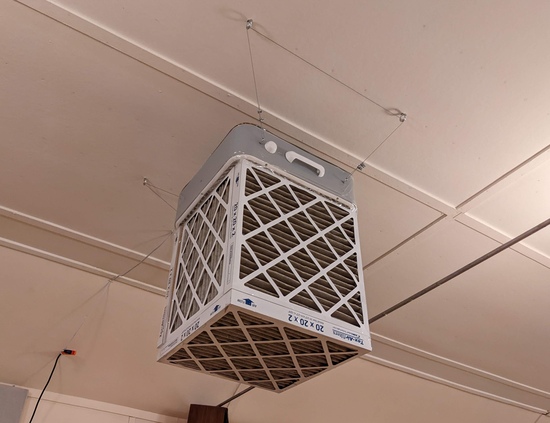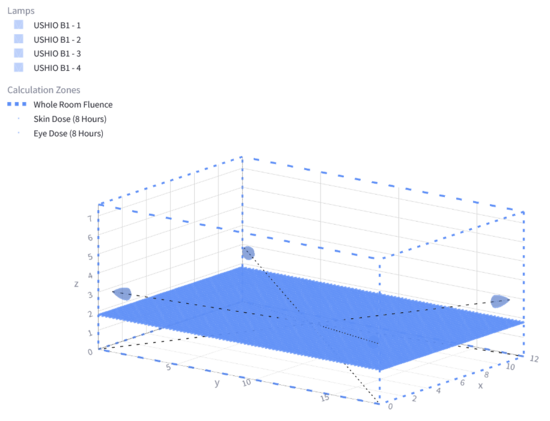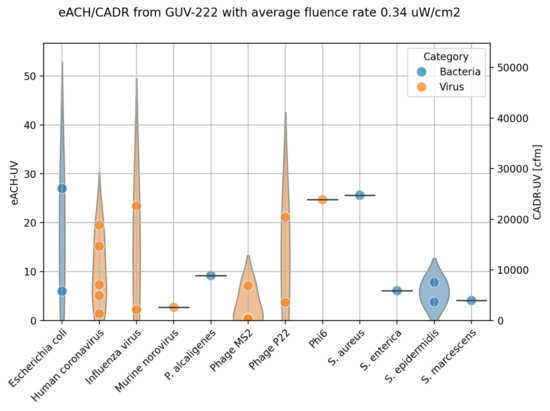Alternatives to Masks for Infectious Aerosols |
December 8th, 2024 |
| airquality, bio, contra, covid-19, masks, organizing, purifiers |
This is a personal post: I'm not speaking for SecureBio or BIDA.
I help organize a contra dance that requires high filtration masks (N95 etc) at half of our dances. When we restarted in 2022 we required masks at all our dances, before switching to half in 2023. We just ran a survey of our dancers, and while there are people who would like to not have to wear masks there are also a lot of people who are only willing to come if they know all the dancers will be masked. [1]
Last week I attended a conference for work with a lot of people thinking about biosecurity, which has me wondering about ways we could have a hall as safe as one where the dancers are all wearing N95s but without the ways N95s make it harder to dance.
We're using N95 for two purposes:
Source control: reducing the amount of droplets and aerosols that are breathed out which go on to enter the air of the room.
Respiratory protection: reducing the amount of droplets and aerosols in the room air that end up inside people.
Since the overall goal is to have a space where people can come and dance at a lower risk of respiratory infection, let's assume that regardless of how we change policy the people who are trying to protect themselves will continue to wear N95s for their own respiratory protection. Is there something we could do to equal the source control benefits of N95s but that's more pleasant for dancing?
If we moved our dancing outside (we can't), or managed to get equivalent ventilation to being outside (really not practical) we could potentially stop with source control entirely. With so much ventilation the aerosols would disperse extremely quickly, giving air that's much cleaner than the N95-filtered air we currently have. While the benefits for droplets aren't going to be as high, I think that's outweighed by the effects of the former.
Since that's not on the table, though, I think we'd need to stick with at least surgical masks for source control. These do a good job with droplets, but not much with aerosols. What would our options be for aerosols?
The first question is, how much clean air do we need? Ventilation is usually given in CFM/person: cubic feet of clean air, per minute, per person. This isn't perfect, since all else equal a larger room is safer, but it's pretty good. ASHRAE Standard 241-2023 ("Control of Infectious Aerosols") recommends 80 CFM in gyms, their closest scenario to dance halls. [2] Since the dance has a peak attendance of ~290 people we'd like 23k CFM.
We currently have two 42" barrel fans, each rated for 15k CFM. But that's their performance if unobstructed, and (a) their location isn't ideal in our space and (b) one is blowing in and one is blowing out. I'm going to guess we get about 8k CFM from the two fans. [3] This is above the 20 CFM/person ASHRAE recommendation for regular ventilation in a dance hall (20 CFM/person * 290 people = 5.6k CFM), but still leaves us 15k CFM shy of our 80/CFM infectious aerosol control target.
What are our options for covering the rest?
More ventilation. This is practical in a lot of venues, either by running the HVAC at a higher flow or with more windows. In our case, however, we're already at the limit of what is possible in this space with its physical layout and agreements with the city and neighbors.
Commercial air purifiers. An air purifier (ex: the AirFanta 3Pro, review) removes particles from the air with filters. They're evaluated by their clean-air delivery rate (CADR), which tells you the CFM of outdoor air you'd need to have a comparable effect. [4] A commercial purifier will list a CADR in its specs, and the AirFanta 3Pro says 413 CFM on high. To get 15k CFM we'd need 36 (!) of these, at $13k. That's just barely practical: it's one every 5.5 feet around the permiter of the room. But storing them when not in use, or building permanent mounting, would be a lot of work. Also, at 55dB each, 36 would be a bit noisy, though not impractically so. [5]
-
DIY air purifiers. During covid a lot of people built Corsi-Rosenthal boxes. These are cheap to make and have higher CADRs: Wikipedia cites this 2022 study as something like 700 CFM for their best design. Some dances (ex: Montpelier) have mounted them permanently from the ceiling, which gets them out of the way:
Unfortunately you still need a lot: even at 700CFM you'd need 22 to get the 15k we're looking for. And this hall would be unlikely to let us hang them.
Upper-room UV. Upper-room ultraviolet light is a traditional (ex: CDC) but not widely used method for reducing infection risk from airborne particles. A bulb is cheap and simple: a fluorescent light combines a mercury vapor that puts out 254nm UV with a phosphor coating that converts the UV into visible light; leave off the coating and you have just the UV. On the other hand, UV in this range is bad for humans, so you need to ensure—through fixture design, placement, and management of reflections—that human exposure is very low. Installations need to be professionally designed, and, while I've called several companies on the UVSolutions Buyers Guide for ambient air treatment, I haven't found someone. I'd still be excited to see someone start something in this area.
-
Far-UV. Instead of using 254nm UV, which is dangerous for humans, you can use 222nm UV ("far UVC") light, which is much safer because it is mostly blocked by our top layers of dead skin. But because it is still a kind of light, it (a) does really well in large rooms with high ceilings because the beams pass through a lot more air and (b) it doesn't have a noisy fan. Talking to UV researcher Vivian Belenky at the Columbia Center for Radiological Research, they used their modeling software to estimate that for a room this size (40x60ft, with a 25ft ceiling) four lamps on portable 10ft stands would be in the right ballpark:
They recommended I write to OSLUV to ask about event kits, but I haven't received a response. (I did only write on Thursday, so they may still reply!)
With the Bioabundance UVPro, built around a Ushio Care 222 B1 filtered KrCl emitter (OSLUV evalluation), each lamp would cost $1.7k for a total of $6.8k. This would give UV disinfection equivalent to a CADR of 5k to 25k depending on the study and pathogen.
Glycol vapor. Running a fog machine, which puts out glycol vapor, is a surprisingly effective way to reduce risk from airborne pathogens. You run it at a much lower level than what's used in theaters, low enough that it's not making visible fog. Talking to Aman Patel at the non-profit research organization Blueprint Biosecurity, it reduces pathogen concentrations by something like two orders of magnitude [6]. He recommended a standard fog machine (~$100) with triethylene glycol (instead of the more common propyelene glycol) which costs about $50/gal. If you're bringing in 8k CFM via the fan, then you need to be putting out enough TEG to keep that flow saturated. I calculate [7] this is 0.3 ml per minute, so over a three hour event it would be 53ml. This is just 2oz of liquid TEG, about $0.78. This seems very promising; I wonder why more people don't do it?
Overall, it looks to me like glycol vapor would be ideal, combining low costs and practical logistics. The main downsides are:
- People may be concerned about safety, but we're talking about levels well below what's common in entertainment.
- Efficacy is not as established as I'd like.
Since the efficacy is still somewhat unclear, I'd like to combine glycol vapor with another system to supplement the ventilation. I think the second-best option is UVC: if the lamps run for 1k hours before burning out then the system costs $7/hr to run, or $20/dance.
[EDIT: Vivian wrote to say that 1k hours is a very pessimistic lifetime estimate, and they would expect something like 10x that. This would naively bring it down to ~$2/dance, but at this point we're talking a hundred years worth of dances. Allocating the cost over 10y of dances it would be $19/dance.]
I'm considering suggesting trialing using far-UVC and TEG [8], and if that goes well would propose allowing surgical masks as an alternative to N95s.
[1] Sometimes I hear people complain about long-running covid caution,
but I actually think its great. It keeps mask-wearing and other
infection-reduction precautions normal, is insurance against the risk
that the general non-cautious public is massively underestimating the
harm of infection, and means that in the next pandemic some people
will be protected even before we know there's something to protect
against.
[2] We can also check ASHRAE 62.1-2022 ("Ventilation and Acceptable Indoor Air Quality") which is general ventilation, not specific to infectious aerosols. It gives the same values for dance halls ("Occupant activity is high. There is considerable aerobic activity. There are often considerable quantities of open drink, creating high levels of space-related contaminants related to the people using the space.") and gyms ("Occupant activity is high. There is considerable aerobic activity. There are no significant space-related contaminants. Occupancy is variable, and the high area outdoor air rate compensates for the varying occupancy and local source.").
[3] Harris took CO2 readings at several of our dances. Combining his readings with mine from 2022-05-19, I see the following CO2 levels:
| Recorded Attendance | Peak CO2 |
|---|---|
| 171 | 1,400 |
| 214 | 2,200 |
| 174 | 2,100 |
| 180 | 1,100 |
| 177 | 2,000 |
| 74 | 900 |
Note that "recorded attendance" is on the low side, since it doesn't include the band and caller. This is especially relevant for the dance with 74 people, since that was an open band, adding another ~15 people.
The correlation between CO2 levels and attendance is pretty weak, but I think it ought to be possible to estimate our current CFM/person from this data?
[4] Which tells you that HEPA filters are overkill for this application. Instead of removing 99.97% of airborne particles on each pass you can use, say, filters that remove 95%, and your CADR will only drop by 5%. You can make up for this by filtering slightly more air, which is not hard because it's much easier to move air through a 95%-effective filter than a 99.97% one.
[5] Each doubling increases perceived loudness by 6dB, so if they were all in the same place going going from 1 to 36 would take you from 55dB to a quite loud 86db: 55db + 6*log_2(36). But they're spread evenly around the perimeter of the room, so the increase should be much smaller than that.
[6] He cited Gomez et al. 2022, Sultan et al. 2024, Ratliff et al. 2023, Mellody and Bigg 1946, and Styles et al. 2022. I haven't read these, but if you do please let me know what you think!
[7] TEG will have fully saturated the air when its partial pressure equals TEG's vapor pressure. The vapor pressue is very low, just 0.02 Pa. How many liters of TEG would give a partial pressure of 0.02 Pa? Dalton's law of partial pressures says that the partial pressure of a gas is the total pressure times the mole fraction of the gas. We're talking about 8k cubic feet, which is 225 cubic meters. A cubic meter of air weighs about 1.2 kg, so this is 270kg of air. The average molar mass of air is about 30g/mol, so ~9k mol of air.
P_teg = P_total * Mol_teg / Mol_total 0.02 Pa = 100k Pa * Mol_teg / 9k mol Mol_teg = 0.02 Pa / 100k Pa * 9k mol = 0.0018 mol
The molar mass of TEG is 150g/mol, so 0.0018 mol is 0.27g. The density of liquid TEG is 1.1g/cm3, so 0.27g is 0.3cm3.
[8] I would probably buy the devices personally and lend them to BIDA, since BIDA isn't the only situation where I'm interested in trying this sort of thing out.
Comment via: facebook, lesswrong, mastodon, bluesky



